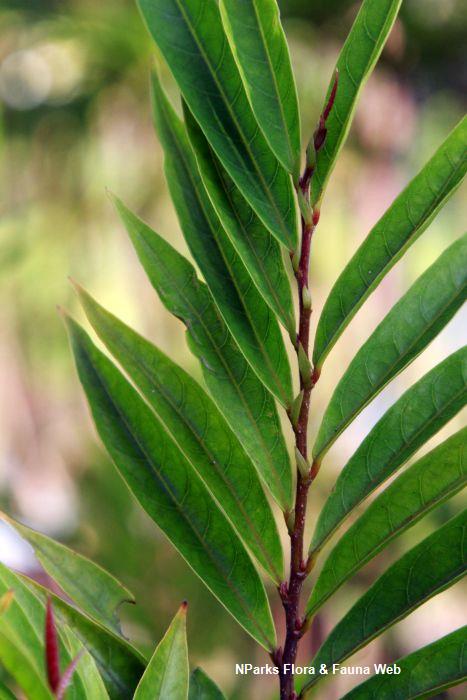
Name
Classifications and Characteristics
| Plant Division | Angiosperms (Flowering Seed Plants) |
|---|---|
| Plant Growth Form | Tree |
| Lifespan (in Singapore) | Perennial |
| Mode of Nutrition | Autotrophic |
| Maximum Height | 11 m |
Biogeography
| Native Distribution | Thailand, Sumatra, Peninsular Malaysia, Singapore, and Borneo |
|---|---|
| Native Habitat | Terrestrial |
| Preferred Climate Zone | Tropical |
| Local Conservation Status | Native to Singapore (Endangered (EN)) |
Description and Ethnobotany
| Growth Form | It is a tree up to 11 m tall. |
|---|---|
| Foliage | Its alternate, stalked leaves have membranous or slightly leathery leaf blades that are elliptic, yellowish-green below, and 7.5-13 by 2.5-5 cm. |
| Flowers | Its yellowish flowers grow on flowering shoots and are about 1 mm across. |
| Fruit | Its fruits are somewhat round, red-purplish, and about 7 mm across. |
| Habitat | It grows on alluvial sites, on hillsides and ridges, and in forests, up to 1300 m altitude. |
| Associated Fauna | Its flowers are insect-pollinated. |
| Etymology | Greek anti, against; Greek desmos, band or bundle; Greek neuron, a nerve; Greek karpos, fruit, the reference to which is unknown |
| Ethnobotanical Uses | Others: Its timber is used in the construction of houses. |
Landscaping Features
| Landscape Uses | Parks & Gardens |
|---|
Fauna, Pollination and Dispersal
| Pollination Method(s) | Biotic (Fauna) |
|---|
Plant Care and Propagation
| Light Preference | Full Sun |
|---|---|
| Water Preference | Moderate Water |
| Plant Growth Rate | Moderate |
References
| References | Ridley, H. N.. 1924. The Flora of the Malay Peninsula. Volume 3. . London.: L. Reeve & Co., Ltd.. vi + 405 pp. Whitmore, T. C.. 1973. Euphorbiaceae. Tree Flora of Malaya. 2: 34–136 |
|---|
Image Repository
Others
| Master ID | 33792 |
|---|---|
| Species ID | 8208 |
| Flora Disclaimer | The information in this website has been compiled from reliable sources, such as reference works on medicinal plants. It is not a substitute for medical advice or treatment and NParks does not purport to provide any medical advice. Readers should always consult his/her physician before using or consuming a plant for medicinal purposes. |




_lowres.jpg)


